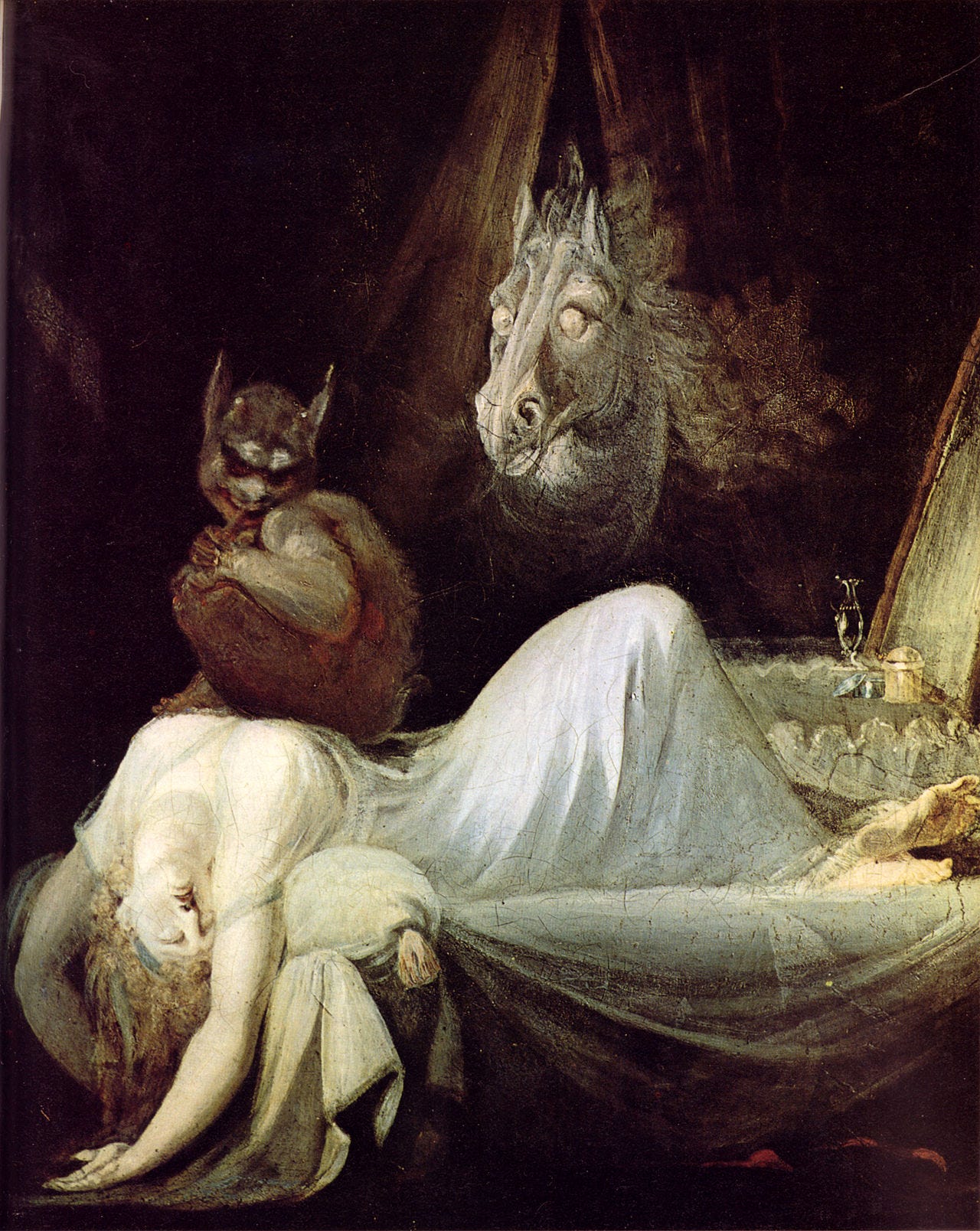Ross und Reiter sind ein Doppelwesen. —M. Jähns, Ross und Reiter in Leben und Sprache, Glauben und Geschichte der Deutschen, 1872, 162.
Alonso’s horse then came to him in nightmares.
Ernest Jones contributes the entirety of Part II of On the Nightmare to “The Mare and the Mara: A Psycho-analytical Contribution to Etymology”. “The word Nightmare,” he states,
itself comes from the Anglo Saxon neaht or nicht (=night) and mara (=incubus or succubus). The Anglo Saxon suffix a denotes an agent, so that mara from the verb merran, literally means a crusher…”1
The Spanish etymology for pesadilla also suggests oppression and weight, as do the Italian pesaruole and the French cauchemar, with its implication of a spur (a first hint at riding, with all its sexual connotations).
The conflation with mare, the female horse —as is also the case with the Dutch— may derive the mara from mar —the Old High German for horse— “making the idea of horse the primary one in the whole group of Nightmare sagas to a quite unjustifiable extent”2, though Jones later cites Jähns on the: “[…] intimate juxtaposition of horse and woman in poetry, proverbial wisdom and sayings […] This juxtaposition is primeval.”
More importantly from a psychoanalytic perspective is the connection between the female horse and the night hag exists even where the linguistic connection does not. Jones relates it to infantile sexuality and the incest complex, adducing that the animal is, in cases such as these, a proxy for someone, usually a parent. Though I believe the proxy in question, in this instance, may be me: the wife, perhaps in the process of becoming a parent, by proxy —indeed, a projected thoroughbred broodmare.
Alonso’s mare is thus a crusher, an oppressor, with these curious characteristics.
The first is she was at least twice a double. For starters, she was pregnant, something anyone who knows us closely is aware has occupied us considerably over the past year. In the second place, while she was not the horse he intended to visit, she was the only other pale horse in dusky premises, and so the case of mistaken identity ensued: two near-identical mares, both heavy with foal, each bearing names with red in them. The daymare was called Carmine. The nightmare was Cerezo Rojo. Carmine had a scar above her eye that Alonso had to feel for to identify her. Cerezo Rojo was intact, and tactless.
As a mythologist, Alonso is well-acquainted with the issue of doubles. They result in two general effects: completeness —as in the case of Parsifal and his Persian half-brother Feirefiz— or the literalisation of duplicity —as with the two Guiniveres. Lore has it that horse-people, somewhat like kitsune, are closely associated to stories of metamorphosis: “The visitor appears, now as a human being, now as a horse, and one may change directly into the other. This interchange is all the more easily effected in that horse and rider are often identified as one in the imagination.”3
I also privately refer to the Id as The Horse, and I know there are certain individuals whose Horse and mine should never meet. As Jones states, the “two attributes of the horse that have especially caught the imagination are (1) his strong, swift movement and (2) his magnificent shining appearance.”4
There is thus something of the Klossowskian simulacrum to the horse, who in movement and speed, appearance and apparition, can be readily construed as the willed actualisation of a phantasm: that is, an “obsessional image produced instinctively from the life of the impulses, [whereas] the simulacrum, in its imitative sense, is the actualization of something in itself incommunicable and nonrepresentable: the phantasm in its obsessional constraint.”5
Alonso’s encounter with the horse took place in real life so it could acquire a phantasmic grip on him that dreams can rarely ensure. The accident was not designed to kill or maim, but to haunt. Now I can come to him in dreams.
Henry Fuseli. The Nightmare. 1781. Oil on canvas. 101.6 cm × 127 cm. Detroit Institute of the Arts, Detroit Michigan.
Given the popularity of the painting, Fuseli painted a number of versions, including this second 1790–91 variation.
Ernest Jones. On the Nightmare. London: The Hogarth Press and the Institute of Psycho-analysis, 1949, p. 243.
Idem, p. 244.
Idem, p. 254. Coincidentally, my unfinished novel, Toccata/fugue, starts with Samuel Bentham glimpsing a rider/writer at an indiscernible distance, and mistaking him for a mirage, or a centaur. The rider arrives with a strange woman sitting behind him on the horse: a wife who is days away from laying an egg in the midst of the lands being developed by the Benthams for Potemkin.
Idem, p. 251.
Pierre Klossowski. Nietzsche and the Vicious Circle. Chicago: University of Chicago Press, 1998 [1969]. Just today, Twitter kindly fed me the following statement by Badiou: “In the serenity of the concept, let us say that not everything that changes is an event, and that surprise, speed and disorder can be the mere simulacra of an event, and not its promise of truth”.





